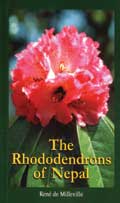 If you were asked to name one other recognisable symbol of Nepal besides our distinctive national flag, you would not hesitate to answer: the rhododendron flower. This amazing blossom that smears entire mountainsides red, white and pink in the Himalayan spring has always been the botanical equivalent of the khukuri to remind Nepalis of their unity. And also diversity. What we think of as one flower elevated to a national icon actually has a huge diversity of colours, shapes and sub-species.
If you were asked to name one other recognisable symbol of Nepal besides our distinctive national flag, you would not hesitate to answer: the rhododendron flower. This amazing blossom that smears entire mountainsides red, white and pink in the Himalayan spring has always been the botanical equivalent of the khukuri to remind Nepalis of their unity. And also diversity. What we think of as one flower elevated to a national icon actually has a huge diversity of colours, shapes and sub-species.
And this is what gradually dawns on readers as they go through Rene de Milleville's recent book on the rhododendrons of Nepal. Taking pictures of rhododendrons shouldn't be such a difficult exercise since the flower is so photogenic to start with. But Milleville has been successful in capturing not just the beauty of a rhododendron forest, but also the sheer variety of blossoms all over Nepal. Despite its technical details, this is still a book by an amateur for amateurs. Rhododendron-watching was a hobby for the outdoors-loving Melleville, but he has taken a lot of trouble to adhere to careful scientific accuracy throughout the book.
Latin names and botanical nomenclatures can be eye-glazers for the lay reader, but Melleville avoids drab academese and punctuates the text with brilliant illustrations and informative charts. Here is a book that will tell you everything you always wanted to know about rhododendrons, and more. The taxonomical history of the flower, its botanical ancestry in the wet mountains and cloud forests of China's Yunnan province all provide fascinating facts.
Besides your Lonely Planet Guide and Birds of Nepal, here is another book you must henceforth carry while on a spring trek in Nepal. And there is now a reason to time your trek for that particular week in April-May when rhododendrons explode across the Nepal's mountains. Just like tourists flock to New England for fall colours, rhododendron tourism can be a great selling point for trekking.
Melleville's book cuts through the jargon and technicalities of the flower and decodes it into simple terms. All 31 species of Nepali rhododendrons and their varieties are described and illustrated to guide the readers through the diversity of this floral treasure that adorns our mountains.
Its pocketbook size and 275g weight means it won't be too much of a burden in your rucksack. (At Rs750, it also won't burn a big hole in your pocket.) At 136 pages with soft cover, it is packed with information that is useful in the field to refer flowers, trees and shrubs that you come across on the trails. The 18 chapters are short and sweet, and they are not top-heavy with text. What is most useful is the graph that provides a simple guide to working out which species can be seen in which locality and altitude at which time.
Milleville has spent 35 years photographing these rhododendrons in the wild. None of the pictures taken between 1962 to 1997 were snapped in a garden or a conservatorium. No artificial lights have been used.
These are pictures that take us to the wild and show us the flowers in natural light. Milleville is not only a passionate trekker and mountain climber, but a conservationist as well. His passion to establish a rhododendron reserve in the Milke Danda of eastern Nepal has been duly taken up by the IUCN-World Conservation Union, Nepal.
Milleville calls Milke Danda "truly a natural world heritage site", and the high ridge in eastern Nepal is already in the process of being preserved by local communities as a "People's Park". Melleville is donating all proceeds from the sale of the book to Rotary Clubs in Nepal to be used for the welfare of the blind.
You don't have to be a trekker or adventurer to use this book. Any car-bound flower lover can also find it a useful guide. Perhaps try to domesticate the rhododendron in Kathmandu, which is no mean feat. (You have to find a shady and relatively dry patch in your garden.)
So, look out for the cover of a life-size Rhododendron arboreum in a bookshop near you with the Himalaya and alpine vegetation in the background.
(Dr Tirtha Bahadur Shrestha is a well-known Nepali botanist and conservationist.)

The Rhododendrons of Nepal
by Rene de Milleville
Himal Books, 2002
136 pages (plus preface, etc)
Rs 750
(Proceeds to go to the Rotary Club for its
Anti-blindness Programme)


